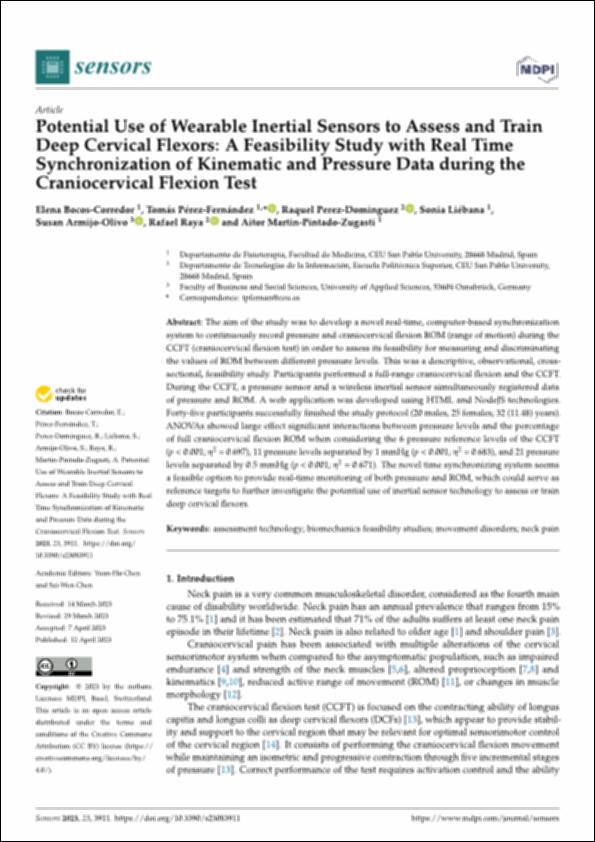Please use this identifier to cite or link to this item:
http://hdl.handle.net/10637/14927Potential Use of Wearable Inertial Sensors to Assess and Train Deep Cervical Flexors: A Feasibility Study with Real Time Synchronization of Kinematic and Pressure Data during the Craniocervical Flexion Test
| Title: | Potential Use of Wearable Inertial Sensors to Assess and Train Deep Cervical Flexors: A Feasibility Study with Real Time Synchronization of Kinematic and Pressure Data during the Craniocervical Flexion Test |
| Authors : | Bocos Corredor, Elena Pérez Fernández, Tomás Perez Domínguez, Raquel Liébana Sánchez-Toscano, Sonia Armijo Olivo, Susan Raya López, Rafael Martin-Pintado Zugasti, Aitor |
| Keywords: | Assessment technology; Biomechanics feasibility studies; Movement disorders; Neck pain |
| Publisher: | MDPI |
| Citation: | Bocos-Corredor E, Pérez-Fernández T, Perez-Dominguez R, Liébana S, Armijo-Olivo S, Raya R, Martin-Pintado-Zugasti A. Potential Use of Wearable Inertial Sensors to Assess and Train Deep Cervical Flexors: A Feasibility Study with Real Time Synchronization of Kinematic and Pressure Data during the Craniocervical Flexion Test. Sensors (Basel). 2023 Apr 12;23(8):3911. doi: 10.3390/s23083911. PMID: 37112252; PMCID: PMC10141233. |
| Abstract: | The aim of the study was to develop a novel real-time, computer-based synchronization system to continuously record pressure and craniocervical flexion ROM (range of motion) during the CCFT (craniocervical flexion test) in order to assess its feasibility for measuring and discriminating the values of ROM between different pressure levels. This was a descriptive, observational, crosssectional, feasibility study. Participants performed a full-range craniocervical flexion and the CCFT. During the CCFT, a pressure sensor and a wireless inertial sensor simultaneously registered data of pressure and ROM. A web application was developed using HTML and NodeJS technologies. Forty-five participants successfully finished the study protocol (20 males, 25 females; 32 (11.48) years). ANOVAs showed large effect significant interactions between pressure levels and the percentage of full craniocervical flexion ROM when considering the 6 pressure reference levels of the CCFT (p < 0.001; 2 = 0.697), 11 pressure levels separated by 1 mmHg (p < 0.001; 2 = 0.683), and 21 pressure levels separated by 0.5 mmHg (p < 0.001; 2 = 0.671). The novel time synchronizing system seems a feasible option to provide real-time monitoring of both pressure and ROM, which could serve as reference targets to further investigate the potential use of inertial sensor technology to assess or train deep cervical flexors. |
| URI: | http://hdl.handle.net/10637/14927 |
| Rights : | http://creativecommons.org/licenses/by/4.0/deed.es |
| ISSN: | 1424-8220 |
| Issue Date: | 12-Apr-2023 |
| Center : | Universidad San Pablo-CEU |
| Appears in Collections: | Fisioterapia |
Items in DSpace are protected by copyright, with all rights reserved, unless otherwise indicated.


